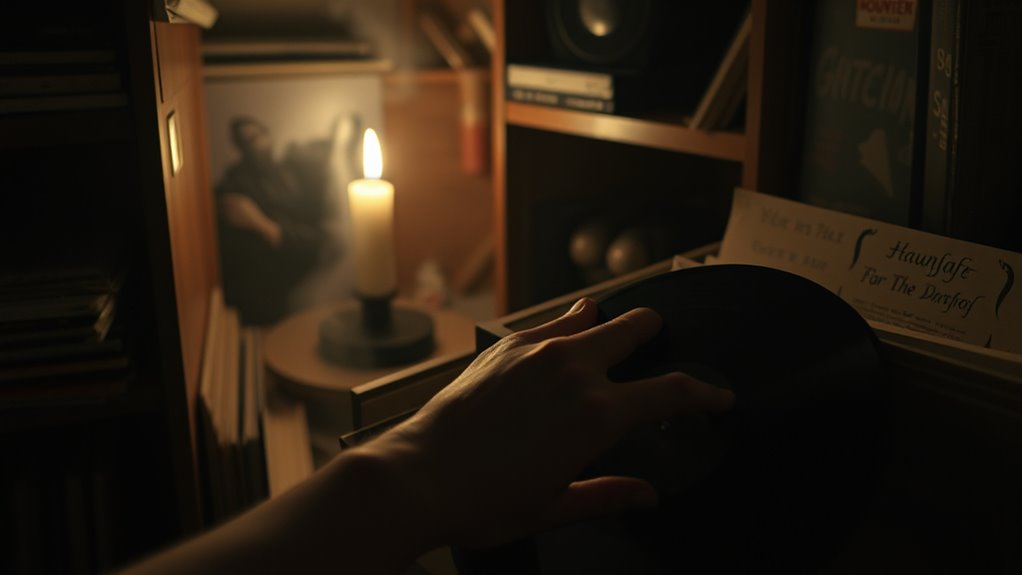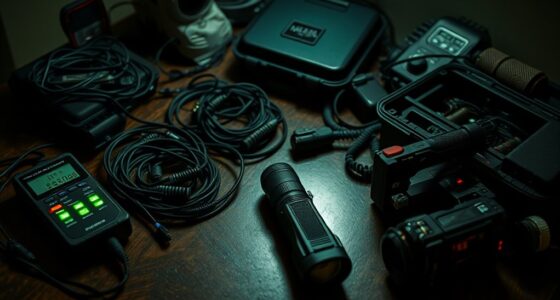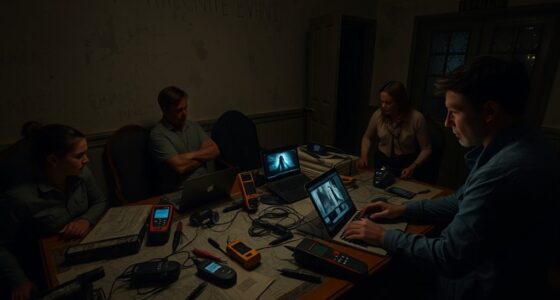To choose the perfect background music for your paranormal show, focus on matching the mood—use eerie, haunting sounds or subtle tension-building tracks to create suspense. Incorporate sound effects like whispers or footsteps to enhance the haunted atmosphere, and use silence strategically to build anticipation. Whether opting for stock music or original scores, consider your audience’s expectations and balance it carefully with narration. Keep experimenting with these elements to craft an immersive experience that keeps viewers hooked.
Key Takeaways
- Match the music style to evoke eerie, mysterious, or suspenseful atmospheres aligned with the show’s narrative tone.
- Use subtle, layered sound effects and ambient sounds to enhance ghostly or unsettling environments.
- Balance background music carefully to support narration without overpowering dialogue or key moments.
- Incorporate silence strategically to build tension and anticipation before reveals or scares.
- Explore stock music for cost-effective options or original scores for a unique, emotionally resonant experience.
Understanding the Atmosphere You Want to Create
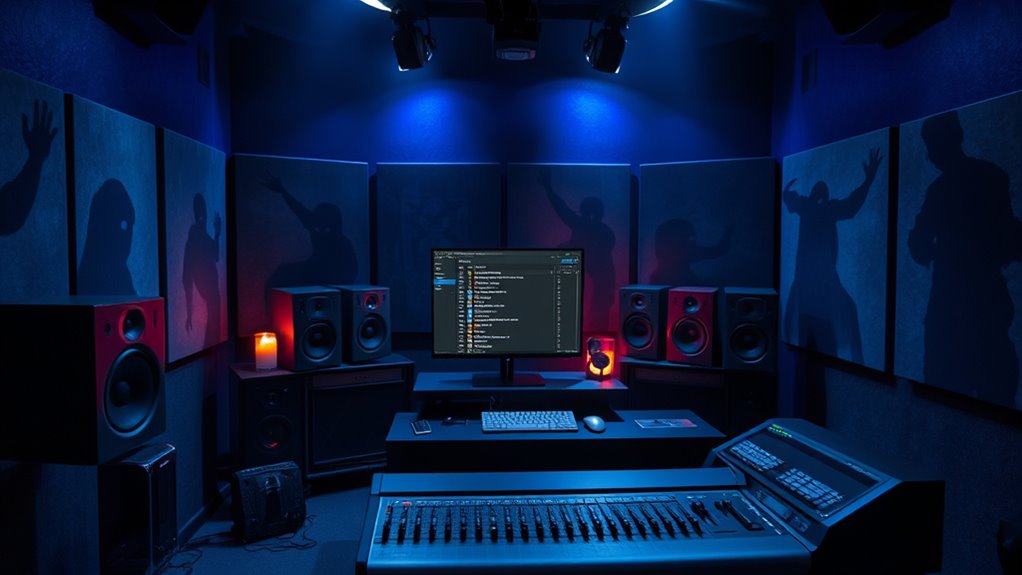
To effectively choose background music for your paranormal show, you need to first understand the atmosphere you want to evoke. Think about the mood you’re aiming for—mysterious, eerie, or suspenseful. Do you want listeners to feel a chill down their spine or a sense of calm curiosity? Consider the story or topic each episode covers, and how music can support that narrative. Are you creating a haunted house vibe, or highlighting paranormal investigations? Visualize the setting and emotional tone you’re trying to establish. Clarifying this will guide your music choices, ensuring they enhance the overall experience without overpowering your content. When you know the desired atmosphere, selecting the right soundtrack becomes much more intuitive and impactful. Additionally, understanding the emotional tone you wish to set can help you select music that resonates deeply with your audience, enriching the paranormal experience.
Selecting Music That Matches the Tone of Your Show
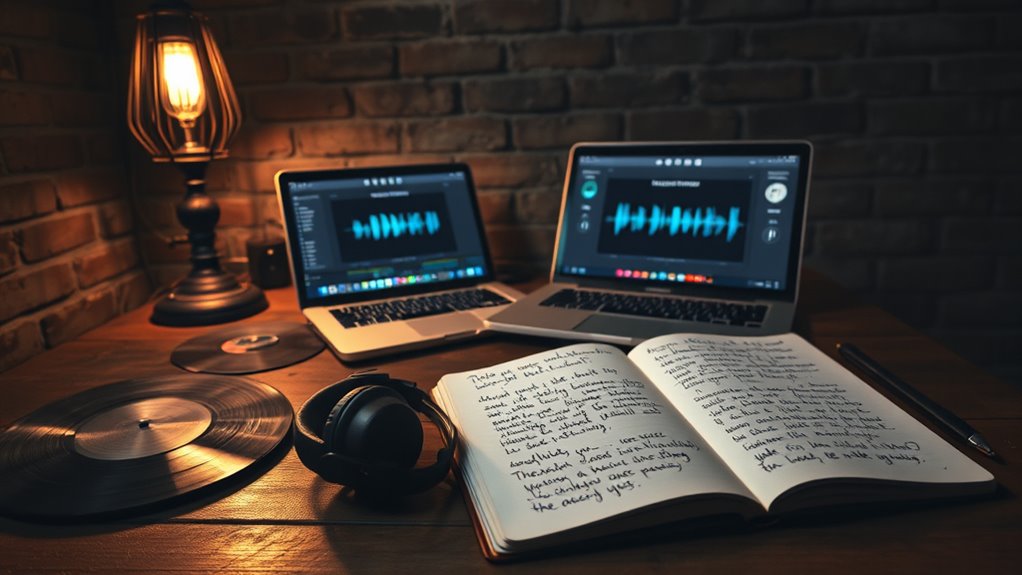
To select music that fits your show’s tone, you need to consider both the overall ambiance and the story you’re telling. If your show has a spooky or eerie vibe, choose tracks that heighten that feeling, while more mysterious stories might call for subtle, suspenseful melodies. Make sure the music aligns with your narrative style to keep viewers immersed and engaged throughout. Additionally, understanding the role of sound effects can help in blending your music choices seamlessly with other audio elements to enhance the atmosphere.
Match Ambiance and Mood
Choosing background music that aligns with your show’s ambiance and mood is essential for creating an immersive experience. You want your music to enhance the eerie, mysterious atmosphere without overpowering the storytelling. If your show leans toward suspense and tension, opt for subtle, tense melodies with slow builds to keep listeners on edge. For a more haunted or ghostly vibe, incorporate haunting, ethereal sounds that evoke otherworldly sensations. Conversely, if your show has moments of humor or lightheartedness, choose music with playful or whimsical tones. Always consider the emotional impact you want to evoke and select tracks that support that feeling. When the music matches the mood, it deepens your audience’s engagement and makes your paranormal stories resonate more profoundly. Many inspiring quotes from visionaries remind us that the right environment can transform perception and experience.
Align With Narrative Style
Matching your background music to your show’s narrative style guarantees that every element works together seamlessly, enhancing the storytelling experience. If your show has a mysterious, suspenseful tone, choose music with slow tempos, haunting melodies, or subtle sound effects that evoke curiosity and unease. For a more humorous or lighthearted paranormal program, opt for playful tunes or quirky sounds that complement the humor without undermining the supernatural theme. Consider the pacing—rapid, energetic music suits fast-moving investigations, while slow, atmospheric pieces suit reflective or eerie segments. Always align your music choices with the overall mood you want to convey, ensuring that the soundtrack amplifies the story rather than distracting from it. When your music matches your narrative style, your audience stays immersed and emotionally connected. Incorporating appropriate music genres that reflect your show’s tone can further strengthen the connection between your content and its soundtrack.
Utilizing Sound Effects to Enhance the Haunted Feel

Adding eerie ambient layers can create an unsettling atmosphere that keeps viewers on edge. Sudden sound cues, like creaks or whispers, can catch your audience off guard and heighten the sense of fear. By carefully blending these effects, you’ll make your haunted scenes feel more authentic and immersive. Incorporating soundscape design techniques can further enhance the haunted feel and deepen viewer engagement.
Eerie Ambient Layers
Eerie ambient layers play a crucial role in immersing viewers in a haunted atmosphere, and sound effects are essential tools to achieve this. You can create these layers by adding subtle, unsettling noises that fill the background without dominating the scene. Think distant whispers, faint footsteps, or the hum of indecipherable machinery. These sounds should be layered softly, enhancing the environment’s eerie quality without overwhelming the main focus. Use reverb and modulation to give the effects a ghostly, otherworldly feel. The goal is to make your audience feel as though they’re inside a haunted location, constantly on edge. Carefully crafted ambient layers deepen the sense of mystery, making the paranormal experience more visceral and compelling. Incorporating high-quality audio equipment ensures that these subtle effects are clear and immersive, amplifying the haunted atmosphere effectively.
Sudden Sound Cues
Sudden sound cues are powerful tools for heightening the haunted atmosphere and catching your audience off guard. They create a jarring effect that amplifies suspense and mystery. To achieve this, consider using:
- A sharp, loud bang that echoes unexpectedly, startling viewers.
- An abrupt whisper or whispers that seem to come from nowhere.
- The sudden crackle of static or electrical interference, implying unseen forces.
- A quick, eerie scream that pierces silence, signaling danger or presence.
Implementing consistent use of sound effects can also help establish a recognizable auditory signature that enhances the show’s overall mood. These sounds should be well-timed, timing them right before a visual reveal or a quiet moment to maximize impact. Use them sparingly to avoid desensitizing your audience and maintain their sense of suspense and fear.
Incorporating Silence and Silence Breaks Effectively

Effective use of silence and silence breaks can heighten suspense and deepen the audience’s sense of unease. Strategic pauses give viewers a moment to absorb unsettling visuals or whispers, making the moment feel heavier. When you insert silence before a major reveal or jump scare, it creates anticipation that amplifies the impact. Conversely, breaking silence suddenly with a subtle sound can jolt the audience, intensifying their discomfort. Use silence sparingly; too much can make scenes feel sluggish, while too little diminishes its power. Pay attention to pacing—letting scenes breathe with well-placed silences can make the supernatural elements more haunting. Incorporating essential oils for Dizziness Relief or other sensory cues subtly into the background can also enhance the atmosphere and emotional response. Incorporate silence thoughtfully, allowing it to serve as a tool that manipulates emotional response and keeps viewers on edge.
Choosing Between Original Compositions and Stock Music
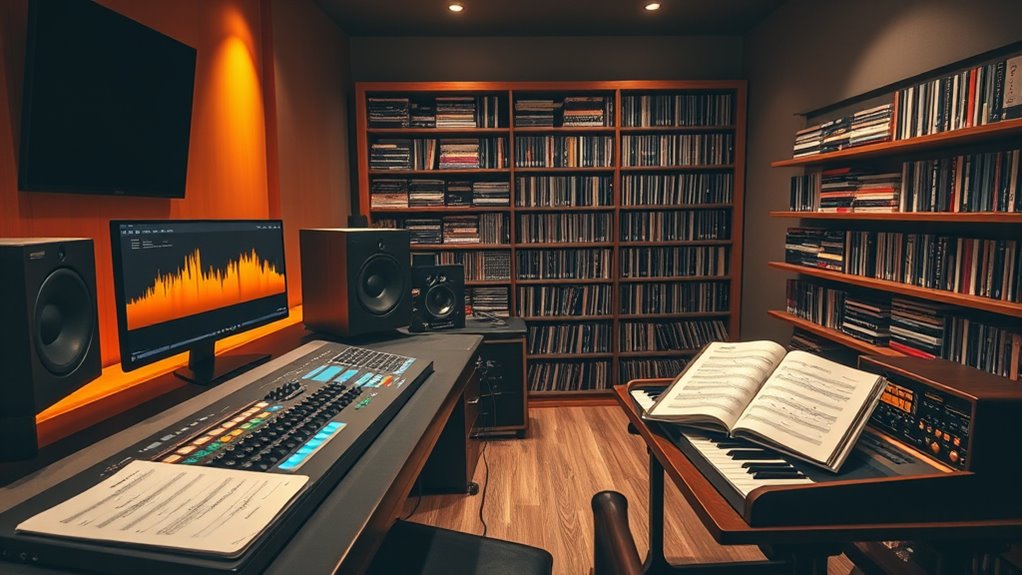
Choosing the right music to accompany paranormal scenes can dramatically influence the audience’s emotional experience. When deciding between original compositions and stock music, consider how each option shapes the mood. Original compositions give you custom sounds tailored to your show’s unique tone, capturing specific themes and intensities. Growth mindset can help you experiment with different musical styles to find what best complements your narrative. Stock music offers a vast library of ready-made tracks, saving time and often fitting common suspense or eerie moods. Original scores can evoke deeper emotional connections by aligning perfectly with your narrative, creating a distinctive atmosphere. Stock music provides cost-effective solutions and quick access, ideal for tight schedules or budget constraints.
Your choice depends on your show’s style and resources. Either path can heighten the paranormal experience—just pick what best amplifies your vision.
Considering Audience Expectations and Preferences
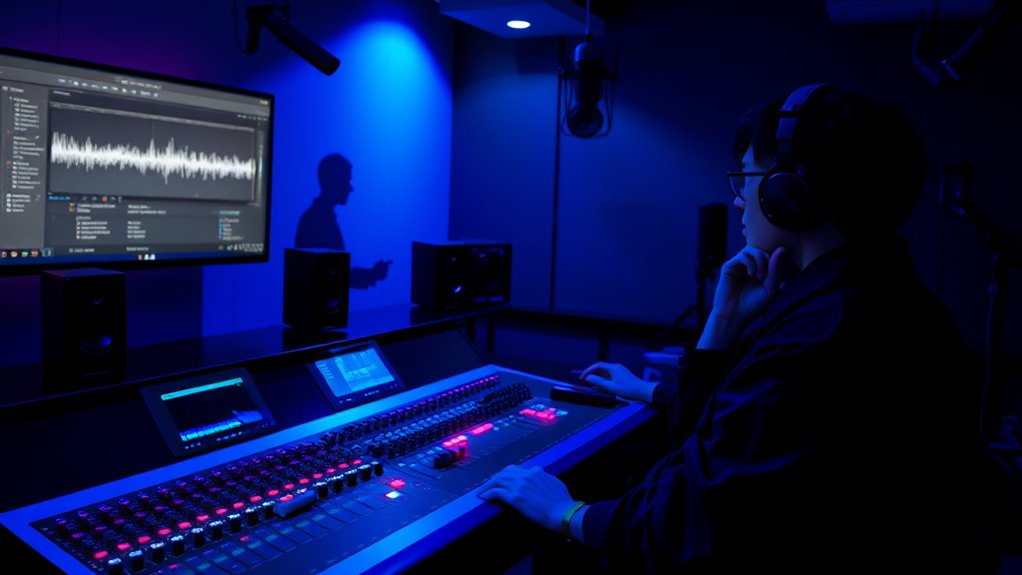
Understanding what your audience expects and prefers is essential when selecting background music for paranormal shows. You want to evoke the right emotions and keep viewers engaged. Think about whether they seek suspense, mystery, or comfort. To guide your choice, consider their typical reactions:
| Emotion | Music Style |
|---|---|
| Intrigue | Subtle, eerie melodies |
| Fear/Unease | Dissonant, tense sounds |
| Comfort/Curiosity | Soft, ambient tones |
Matching music to these emotions helps create a compelling atmosphere. If your audience craves suspense, use music that heightens tension. For those seeking reassurance, opt for gentler sounds. Always keep their expectations in mind, and tailor your soundtrack to enhance their experience. Incorporating audience preferences into your selection ensures a more captivating and immersive paranormal presentation.
Balancing Background Music With Narration and Dialogue

Balancing background music with narration and dialogue is essential for maintaining clarity and audience engagement. You want the music to enhance the mood without overpowering spoken words. To achieve this, consider these key points:
Balance music and dialogue carefully to keep clarity and engage your audience effectively.
- Adjust volume levels so dialogue remains crisp and clear, like a spotlight on your voice.
- Use subtle fades and pauses in music to let important narration breathe.
- Choose music that complements the scene, like a gentle breeze rather than a storm.
- Regularly listen and tweak, imagining your audience’s experience as if they’re right there with you.
Testing and Refining Your Soundtrack to Maximize Impact
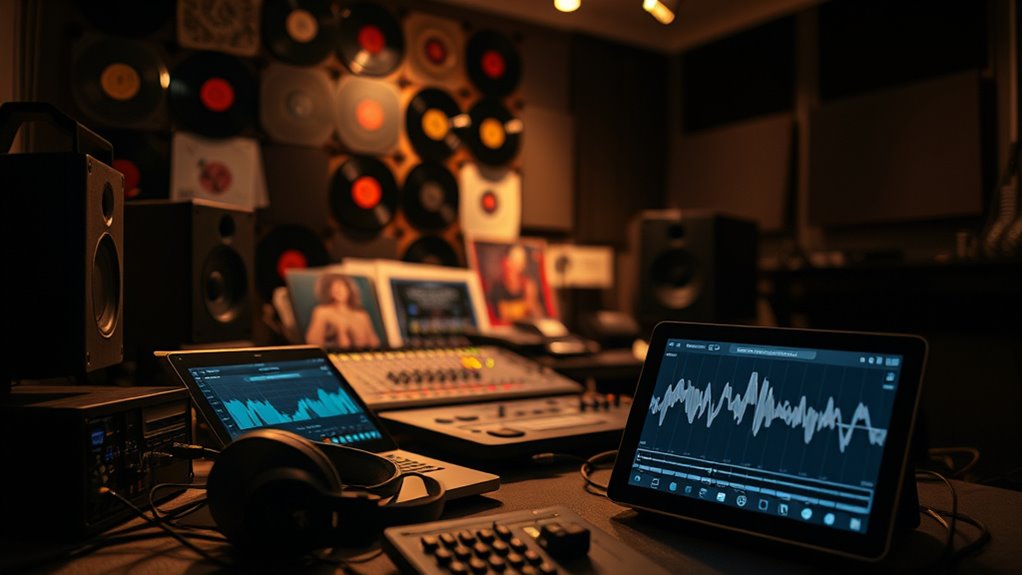
Testing and refining your soundtrack is a crucial step to guarantee your paranormal show hits the right emotional notes. Play different versions of your music during recordings or edits, paying close attention to how they influence the mood. Listen critically, and ask yourself if the music enhances the scene without overpowering narration or dialogue. Gather feedback from trusted colleagues or test audiences, noting their emotional reactions. Adjust volume levels, timing, and instrumentation to better align with the scene’s intent. Sometimes, subtle tweaks—like changing a pause or adjusting a pitch—make a big difference. Keep refining until the soundtrack complements each moment seamlessly, creating an immersive experience that heightens suspense and emotion. This process ensures your show resonates deeply with viewers.
Frequently Asked Questions
How Can I Ensure the Music Doesn’t Overpower the Narration?
To make certain the music doesn’t overpower your narration, keep the volume levels balanced. Lower the background music during speaking parts and raise it slightly during suspenseful moments. Use equalizer settings to cut frequencies that clash with your voice, and choose softer, less intrusive tracks. Regularly listen back to your recordings to check clarity, and consider using ducking techniques that automatically reduce music volume when you speak.
What Are the Best Sources for High-Quality Paranormal-Themed Music?
Think of your soundtrack as a ghostly whisper — subtle yet impactful. For high-quality paranormal-themed music, explore platforms like Epidemic Sound, Artlist, and PremiumBeat, which offer curated, royalty-free tracks. I once found an eerie, haunting tune on Artlist that became the show’s signature, proving the importance of selecting authentic, atmospheric music. These sources guarantee your show’s mood stays chilling without overpowering your narration.
How Do I Adapt Background Music for Different Episode Segments?
You adapt background music for different episode segments by matching the tone and mood to each part. Use eerie, tense tracks for suspenseful moments, and switch to softer, reflective tunes for interviews or recaps. Adjust the volume so it enhances without overpowering your narration. Incorporate subtle changes in tempo and instrumentation to signal shifts in scenes, keeping your audience engaged and emotionally connected throughout the episode.
What Legal Considerations Are There When Using Stock or Original Music?
You should always guarantee proper licenses when using stock or original music to avoid legal trouble. Even if the music is royalty-free, check the licensing terms to ensure you can use it in your show. Register original compositions if needed, and credit the creators appropriately. This way, you protect yourself from copyright claims and ensure your paranormal show remains compliant and professional.
How Can I Gauge Audience Reaction to My Chosen Soundtrack?
You can gauge your audience’s reaction by paying close attention to their engagement levels during your show. Notice their facial expressions, body language, and how they react to specific tracks. You might also ask for direct feedback through polls or comments afterward. Use live reactions, social media comments, and surveys to see if your soundtrack enhances the spooky atmosphere or needs adjusting. This helps you refine your choices effectively.
Conclusion
Ultimately, the right background music can make your paranormal show truly unforgettable—unless, of course, your audience forgets to focus on the story because they’re too busy obsessing over the creepy soundtrack. Ironically, the perfect eeriness often lies in subtlety, not overwhelming noise. So, while you aim to set the perfect haunted mood, remember: sometimes, less really is more. After all, the best scares come from what you don’t hear.
